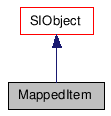Detailed Description
A mapped item specifies the value driven by a specific clip instance (for example, an object's parameter or its geometry).
You can get the MappedItem from Clip::GetMappedItems.
In order to know exactly which type of AnimationSourceItem you are dealing with you can use SIObject::GetType which returns a value contained in the XSI::siAnimationSourceItemType enum.
- See also:
- Clip::GetMappedItems
- Since:
- 4.0
- Example:
- Demonstrates how to use mapped item to look for a specific animation channel. Once this channel is found a clip effect is added onto it.
using namespace XSI; Application app; Model root = app.GetActiveSceneRoot(); X3DObject myCube; root.AddGeometry( L"Cube", L"MeshSurface", L"", myCube ); // Create the first animation source CValueArray args(9); CValue outArg; args[0] = root; args[1] = L"cube.kine.local.posx,cube.kine.local.posy,cube.kine.local.posz"; args[3] = L"StoredStaticPose"; args[4] = true; args[7] = false; args[8] = false; app.ExecuteCommand( L"StoreAction", args, outArg ); Source mySource(outArg); // Create the first clip CValueArray addClipArgs(6); addClipArgs[0] = root; addClipArgs[1] = mySource.GetFullName(); addClipArgs[5] = L"MyClip1"; app.ExecuteCommand( L"AddClip", addClipArgs, outArg ); Clip myClip(outArg); CRefArray mappedItems = myClip.GetMappedItems(); // Find the mapped item on which we want to add an effect. // We are looking for the local.posy parameter LONG i; MappedItem currItem; for(i = 0; i < mappedItems.GetCount(); ++i) { currItem = mappedItems[i]; Parameter param = currItem.GetDestination(); if(param.GetFullName().IsEqualNoCase(L"cube.kine.local.posy")) { CValueArray mappingRuleArgs(4); mappingRuleArgs[0] = myClip.GetFullName() + L".ActionClip"; mappingRuleArgs[1] = param; mappingRuleArgs[2] = L"frame"; mappingRuleArgs[3] = (LONG)(i + 1); app.ExecuteCommand(L"SetMappingRule", mappingRuleArgs, outArg); break; } } ClipEffectItem effectItem(currItem.GetClipEffectItem()); app.LogMessage(L"The expression associated with the posy item is >> " + effectItem.GetExpression());
#include <xsi_mappeditem.h>

Public Member Functions | |
| MappedItem () | |
| ~MappedItem () | |
| MappedItem (const CRef &in_ref) | |
| MappedItem (const MappedItem &in_obj) | |
| bool | IsA (siClassID in_ClassID) const |
| siClassID | GetClassID () const |
| MappedItem & | operator= (const MappedItem &in_obj) |
| MappedItem & | operator= (const CRef &in_ref) |
| CRef | GetAnimationSource () const |
| CRef | GetDestination () const |
| ClipEffectItem | GetClipEffectItem () const |
Constructor & Destructor Documentation
| MappedItem | ( | ) |
Default constructor.
| ~MappedItem | ( | ) |
Default destructor.
| MappedItem | ( | const CRef & | in_ref | ) |
Constructor.
- Parameters:
-
in_ref constant reference object.
| MappedItem | ( | const MappedItem & | in_obj | ) |
Copy constructor.
- Parameters:
-
in_obj constant class object.
Member Function Documentation
| bool IsA | ( | siClassID | in_ClassID | ) | const [virtual] |
Returns true if a given class type is compatible with this API class.
- Parameters:
-
in_ClassID class type.
- Returns:
- true if the class is compatible, false otherwise.
Reimplemented from SIObject.
| siClassID GetClassID | ( | ) | const [virtual] |
| MappedItem& operator= | ( | const MappedItem & | in_obj | ) |
Creates an object from another object. The newly created object is set to empty if the input object is not compatible.
- Parameters:
-
in_obj constant class object.
- Returns:
- The new MappedItem object.
| MappedItem& operator= | ( | const CRef & | in_ref | ) |
Creates an object from a reference object. The newly created object is set to empty if the input reference object is not compatible.
- Parameters:
-
in_ref constant class object.
- Returns:
- The new MappedItem object.
Reimplemented from SIObject.
| CRef GetAnimationSource | ( | ) | const |
Returns the object which is driving the action or shape animation. This function is not available for compound clips. You can test to see whether the clip is a compound clip by testing if SIObject::GetClassID() == siClipContainerID on the Clip object.
- Warning:
- In the case of Expressions or Constraints, this property will return an invalid CRef, because the MappedItem object does not contain the full Expression or Constraint objects.
- Returns:
- A reference to either a ShapeKey, FCurve or StaticSource.
- See also:
- MappedItem.Source2
| CRef GetDestination | ( | ) | const |
| ClipEffectItem GetClipEffectItem | ( | ) | const |
For all items driven by a clip there could be an associated clip effect which would affect the value after the evaluation of the animation source. This function returns the specific item in the ClipEffect which is associated to this mapped item.
- Returns:
- The associated ClipEffectItem.
The documentation for this class was generated from the following file:
